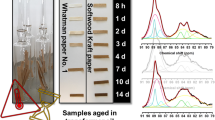Abstract
A series of laboratory-aged transformer insulating papers were investigated using solid-state NMR spectroscopy. Carbon-13 CPMAS, and proton MAS experiments were carried out along with static proton relaxation (T1, and T1ρ) and free induction decay (FID) measurements. Some proton CRAMPS and proton-carbon-13 correlation (WISE) experiments were also undertaken. A change in the proton T1 and FID with ageing was detected. No detectable change was found in the proton T1ρ. Some amorphous cellulose was detected in the carbon-13 spectrum. There was, however, no evidence for a substantial change in the nature of the cellulose with ageing. The carbon-13 spectra from some aged samples showed signals not present in the spectrum from an unaged sample. This was taken to be evidence of chemical degradation. Proton MAS and the WISE exeriment gave some information about the nature of the water in the sample.
Similar content being viewed by others

References
Burum, D. P. and Rhim, W. K. (1979) Analysis of multiple pulse NMR solids,J. Chem. Phys. 71, 944.
Emsley, A. M. and Stevens, G. C. (1994a) Review of chemical indicators of degradation of cellulosic electrical paper insulation in oil-filled transformers,IEE Proc., Sci. Measure. Technol. 141 (5), 324–333.
Emsley, A. M. and Stevens, G. C. (1994b) Kinetics and mechanisms of the low-temperature degradation of cellulose,Cellulose 1, 26–56.
Horii, F., Hirai, A. and Kitamaru, R. (1984) CPMAS carbon-13 NMR study of spin relaxation phenomena of cellulose containing crystalline and noncrystalline components,J. Carbohydr. Chemi. 3 (4), 641–662.
Kenwright, A. M. and Say, B. J. (1993) Solid-state proton NMR studies of polymers, inNMR Spectroscopy of Polymers, (R. N. Ibbett, ed.) Glasgow: Blackie Academic and Professional.
Mansfield, P. (1965) Multiple-pulse NMR transients in solids,Phys. Rev. 137 (3A), 961–974.
McBrierty, V. J. (1974) NMR of solid polymers: a review,Polymer 15, 503–520.
McBrierty, V. J. and Douglass, D. C. (1981) Recent advances in the NMR of solid polymers,J. Polym. Sci.: Macromol. Rev. 16, 295–366.
Schaefer, J. and Stejskal, E. O. (1976) Carbon-13 NMR of polymers spinning at the magic-angle.J. Am. Chem. Soc. 98, 1031–1033.
Schmidt-Rohr, K., Clauss, J. and Spiess, H. W. (1992) Correlation of structure, mobility and morphological information in heterogeneous polymer materials by two-dimensional wideline separation NMR spectroscopy,Macromolecules 25, 3273–3277.
VanderHart, D. L. and Atalla, R. H. (1984) Studies of microstructure in native celluloses using solid-state13C NMR,Macromolecules 17 (8), 1465–1472.
Wehrli, F. W. and Wirthlin, T. (1976)Interpretation of Carbon-13 Spectra, London: Heyden.
Author information
Authors and Affiliations
Rights and permissions
About this article
Cite this article
Ali, M., Apperley, D.C., Eley, C.D. et al. A solid-state NMR study of cellulose degradation. Cellulose 3, 77–90 (1996). https://doi.org/10.1007/BF02228792
Issue Date:
DOI: https://doi.org/10.1007/BF02228792



